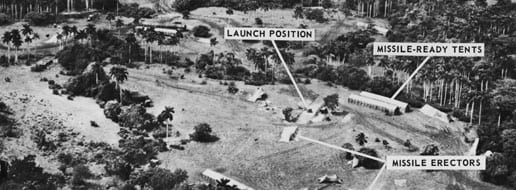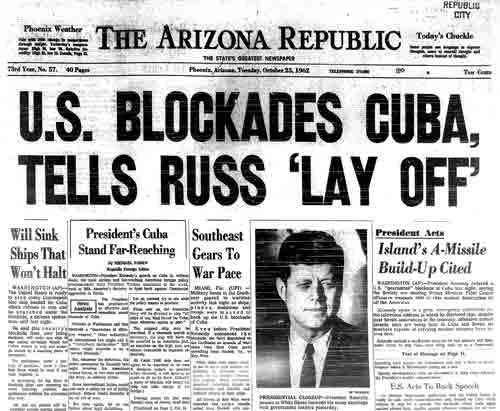When Cuba was the Center of Global Attention
On the Brink of a Nuclear War: 55 Years after the Cuban Missile Crisis
By Guillermo Nova

HAVANA TIMES — The United States and Soviet Union were never so close to a nuclear face-off as they were in October 1962, when the US discovered Soviet missiles on the island.
“The decision to install missiles was the Soviets’ initiative to deter a US invasion,” Tomas Diez Acosta, a retired military man and the best expert on the “October Crisis” in Cuba, told dpa news.
On October 14, 1962, a US Air Force U-2 spy plane flew over Cuban territory and managed to take pictures of missile launching pads with enough range to destroy any city on this eastern coast of the US, from Miami to New York passing through Washington.
Two days later, President John F. Kennedy was informed about the situation alongside a small group of advisers who kept this a secret for a week. In order to win the battle, they needed to not lose their initiative and take the enemy by surprise.
“The purpose of these bases can be none other than to provide a nuclear strike capability against the Western Hemisphere,” Kennedy said on October 22nd in a national address from the Oval Office.
Other options were considered: political negotiations, attacks on selected Cuban targets, a naval blockade and military invasion. Finally, the head of the White House decided to implement a stringent naval blockade, that is to say, to put the island in “quarantine”.
Nearly a hundred US ships were deployed around Cuba and dozens of air force commands patrolled so as intercept Soviet shipments that could bring weapons to Cuba.
The objective was to win time so as to prevent a war that once started would end in a nuclear holocaust.

US intelligence services didn’t know that there were already over 40,000 Soviet militarymen deployed in Cuba, including thousands of soldiers who belonged to the powerful Soviet Strategic Missile Troops which had come to the island as part of “Operation Anadyr”.
The great problem that Cuban and Soviet officers had was to hide missiles that were 24 meters long.
At that time, the Soviet Union was well ahead of the United States in the Space Race, but the US was at the head of the arms race. More than 2,000 missiles were able to reach Moscow against the 340 Soviet ones that could reach the United States.
“A misjudgment would have put us at war with each other,” recalls Tomas Diez, a researcher at the Cuban History Institute, who retired from the Cuban Army with the title of Lieutenant Colonel.
The tensest moments of the Cold War lasted a week. Both parties didn’t want a full-scale war but they couldn’t show themselves giving in to the “enemy”. On October 27th, a US air force U-2 spy plane was shot down in Cuba. The pilot died. Tensions reached their peak at that moment.
Finally, Kennedy and the leader of the Soviet Union, Nikita Khrushchev, negotiated a solution to the conflict behind Cuba’s back. The Soviet Union would withdraw its missiles and the United States would promise not to invade Cuba and would withdraw its missiles in Italy and Turkey which were a threat to Moscow.

The solution reached, without Fidel Castro, was something that the Cuban government didn’t like at all and at political events, Cubans began to sing “Nikita, you fag, you don’t take away what you give.”
“Nikita Khrushchev’s behavior during the 1962 October Crisis really dealt a heavy blow to the image we Cuban people had of the Soviet leadership,” Juan Sanchez, former Cuban Ambassador and currently a professor at Cuba’s University of International Relations, told dpa.
The negotiation behind Cuban leaders’ backs “introduced into the Cuban leaders’ subconscience that it was impossible to completely entrust matters of our national security to our allies,” Sanchez said.
In spite of disagreements between both countries, they have remained two Communist allies for decades. “A historic moment was lost, but from that point on the Soviets used to supply us with arms for free, they were indebted to us,” Tomas Diez points out. However, the shadow of mistrust in the Soviet leadership remained.
“This feeling of uncertainty led us to come up with the doctrine of the war of all the people strategy, which has the defense of our sovereignty with our own forces at the heart of it,” notes Sanchez, who was a Cuban Ambassador in many Eastern European countries.
Key moments of the 1962 Cuban Missile Crisis
The following is a timeline of the key moments in the 1962 “Cuban Missile Crisis”.
October 14th: A US Air Force U-2 spy plane flies over the western part of the island and takes photos of Soviet missile launch pads.
October 15th: The US National Photographic Interpretation Center analyzes these photos and identifies ballistic missile parts. High-ranking officials are informed about this finding.
October 16th: US President John F. Kennedy is informed and creates a team, the Executive Committee of the National Security Council (ExComm), where technical aspects of the real danger that these Soviet missiles might pose and the possible responses that the US should adopt are analyzed.

October 20th: Kennedy discusses the best strategy to follow with his advisers. Defense secretary Robert McNamara defends an attack against Cuba, while the US’ UN Ambassador, Adlai Stevensor, considers offering to withdraw from the naval base at Guantanamo and to dismantle US missiles in Turkey. Kennedy decides to put Cuba in “quarantine” in order to stop Soviet ships from passing through.
October 21st: The US Strategic Air Command warns that an air attack would only destroy 90% of Soviet missiles on the island. Kennedy thinks about the repercussions that the remaining operative 10% could cause.
October 22nd: Kennedy gives a televised speech to the nation where he reveals the existence of missiles in Cuba and announces the naval blockade on the island.
October 23rd: Soviet Union leader Nikita Khrushchev states that US measures are a threat to peace and Moscow puts the Warsaw Pact on alert.
October 24th: Khrushchev claims that the Soviet Union is ready to sink US ships that try to intercept Soviet ships on their way to Cuba. Moscow proposes a summit to Kennedy in order to prevent a full-scale nuclear war. The United States activates DEFCON 2, the most severe alert state before war.
October 25th: The Cuban Missile Crisis is discussed by the United Nations Security Council, where the US ambassador shows photos of missile whose authenticity is denied by the Soviet representative.
October 26th: The Soviet Union (USSR) sends a message to the United States saying that it is willing to withdraw its missiles if Washington promises not to invade Cuba.
October 27th: A US U-2 spy plane is shot down in Cuban airspace. Kennedy orders that no reprisals are taken and sends a telegram to the Soviet Union guaranteeing that it won’t invade Cuba as long as the USSR dismantles its nuclear facilities on the island in exchange.
October 28th: Khrushchev announces the dismantlement of missile facilities in Cuba and Kennedy promises to end spy plane surveillance of the island to allow Soviet ships to pass through to the island. Washington also agrees to withdraw its missiles from Italy and Turkey, as well as not invading the island. Fidel Castro believes this agreement isn’t enough because the economic embargo against Cuba remains in place.
November 20th: Kennedy announces the end of the crisis and lifts the “quarantine”/naval blockage giving Soviet ships access to Cuba. Th missiles return to the Soviet Union.






Whoever calls you an “intellectual infant” should be censored and disallowed such abuses. As in any case where liberty of speech is offered, there are limits. You, me, and everyone else should be permitted to express our opinions on this forum, subject to the standards of our host. If we disagree with determinations of the moderators, we are free to not post and go elsewhere.
Fidel asked Khrushchev for a first strike nuclear attack on the major US east coast cities. Not easily set aside.
The omission is there because the US had no knowledge of Fidel’s letter to Khrushchev at the time. But why does it matter? That was then, this is now. You both need to stop living in the past and continuing to harbor old animosities.
But if you’d like, two can play at that game… if you were honest with yourselves and everyone else, you’d admit that the US government drove Fidel and his revolution into the waiting arms of the Soviet Union after turning their backs on Fidel so many years ago. Fidel initially wanted democracy for Cuba after the triumph of his revolution, and he initially sought help from the US government to advance that goal too. But he was forced to adopt communism instead as a hands-tied prerequisite when later receiving billions in Soviet aid each year after Ike and his paranoid VP Nixon both turned their backs on him. Ever since then, the US government has had nobody to blame but themselves for the entire mess that was Cuba then, and is Cuba today. I realize strong animosities die hard, but we all need to move on and stop beating the past to death. In truth, only the present and the future matter if we’re sincerely interested in repairing the past. It’s not too late for the US government to correct their error and now respectfully help Cuba and her government along the road to recovery, and towards the light of democracy once again in a respectful and non-combative fashion that’s befitting a caring nation.
Agreed. Curious omission from an otherwise complete summary.
A key bit of “trivia” missing from this official Cuban account is the communication from Fidel to Khrushchev encouraging preemptive nuclear holocaust. Just a minor detail. Curious omission. “Propaganda” anyone?